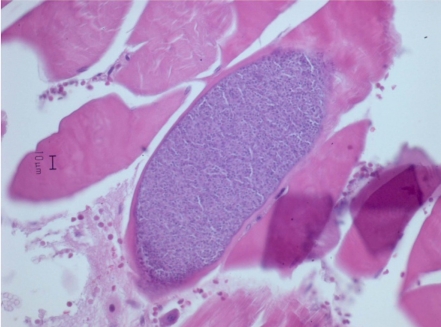Lab Anim Res.
2011 Dec;27(4):357-359. 10.5625/lar.2011.27.4.357.
Detection of sarcocystic infection in a wild rodent (Apodemus agrarius chejuensis) captured on Jeju island
- Affiliations
-
- 1Department of Laboratory Animal Medicine, College of Veterinary Medicine, Seoul National University, Seoul, Korea. pjhak@snu.ac.kr
- 2Department of Microbiology and Immunology, Seoul National University College of Medicine, Seoul, Korea.
- 3Department of Biochemistry, College of Medicine, Konyang University, Daejeon, Korea.
- 4Department of Science Education, Jeju National University, Jeju, Korea.
- 5College of Veterinary Medicine, Kangwon National University, Chuncheon, Korea.
- 6Biological Resources Coordination Division, National Institute of Biological Resources, Incheon, Korea.
- 7Biosafety Research Team, Environmental Health Research Department, National Institute of Environmental Research, Incheon, Korea.
- KMID: 1444971
- DOI: http://doi.org/10.5625/lar.2011.27.4.357
Abstract
- Sarcocystis spp is a causative agent of sarcocystosis. They have a characteristic life cycle infecting both prey and predator. Sarcocystis can cause myositis, atrophy of the adjacent cells and abortion in cattle. In mice, sarcocystosis causes mild cellular reactions without clinical disease. Severe haemorrhage and abortion were also reported. For monitoring the disease in wild rodents of the Korean peninsula, we captured Apodemus agrarius chejuensis on Jeju island and examined the specimen histopathologically. Intramuscular cysts were found and diagnosed as Sarcocystis. Sarcocystic infection has been reported in worldwide. There have been many reported infections in cattle and pigs in Korea. To our knowledge, this is the first report of Sarcocystis in Apodemus agrarius chejuensis captured in Korea.
MeSH Terms
Figure
Reference
-
1. Latif B, Vellayan S, Omar E, Abdullah S, Mat Desa N. Sarcocystosis among wild captive and zoo animals in Malaysia. Korean J Parasitol. 2010; 48(3):213–217. PMID: 20877499.
Article2. Levine ND. The taxonomy of Sarcocystis (protozoa, apicomplexa) species. J Parasitol. 1986; 72(3):372–382. PMID: 3091802.3. Tillmann T, Kamino K, Mohr U. Sarcocystis muris-a rare case in laboratory mice. Lab Anim. 1999; 33(4):390–392. PMID: 10778789.4. Noh JW, Jang DH, Kang YB, Jang H, Wee SH. Effects of temperature on viability of sarcocysts of Sarcocystis cruzi in cardiac muscle of cattle. Korean J Vet Public Health. 1988; 12(2):151–155.5. Wee SH, Shin SS. Experimental induction of the two-host life cycle of Sarcocystis cruzi between dogs and Korean native calves. Korean J Parasitol. 2001; 39(3):227–232. PMID: 11590912.6. Owen IL. Parasitic zoonoses in Papua New Guinea. J Helminthol. 2005; 79(1):1–14. PMID: 15831107.
Article7. Gjerde B. Ultrastructure of the cysts of Sarcocystis grueneri from cardiac muscle of reindeer (Rangifer tarandus tarandus). Z Parasitenkd. 1985; 71(2):189–198. PMID: 3922150.8. Kang SS, Yi YJ, Cui XS, Kwon YB, Cho SK, Choi SH. Sarcocystis infection in farmed elk (Cervus canadensis). Korean J Vet Clin Med. 1999; 16(2):529–532.9. Habeeb YS, Selim MA, Ali MS, Mahmoud LA, Abdel Hadi AM, Shafei A. Serological diagnosis of extraintestinal sarcocystosis. J Egypt Soc Parasitol. 1996; 26:393–400. PMID: 8754648.10. Shaw JJ, Lainson R. Sarcocystis of rodents and marsupials in Brazil. Parasitology. 1969; 59(1):233–244. PMID: 4976872.
Article11. Davis CR, Barr BC, Pascoe JR, Olander HJ, Dubey JP. Hepatic sarcocystosis in a horse. J Parasitol. 1999; 85(5):965–968. PMID: 10577737.
Article12. Dubey JP, Lindsay DS, Speer CA, Fayer R, Livingston CW Jr. Sarcocystis arieticanis and other Sarcocystis species in sheep in the United States. J Parasitol. 1988; 74(6):1033–1038. PMID: 3142990.13. Colwell DD, Mahrt JL. Ultrastructure of the cyst wall and merozoites of Sarcocystis from moose (Alces alces) in Alberta, Canada. Z Parasitenkd. 1981; 65(3):317–329. PMID: 6797140.14. Gjerde B, Dahlgren SS. Corvid birds (Corvidae) act as definitive hosts for Sarcocystis ovalis in moose (Alces alces). Parasitol Res. 2010; 107(6):1445–1453. PMID: 20697910.15. Atkinson CT, Wright SD, Telford SR Jr, McLaughlin GS, Forrester DJ, Roelke ME, McCown JW. Morphology, prevalence, and distribution of Sarcocystis spp. in white-tailed deer (Odocoileus virginianus) from Florida. J Wildl Dis. 1993; 29(1):73–84. PMID: 8445792.16. Moon MH. Sarcocystis infection and identification of Sarcocystis species in pigs in Korea. Korean J Vet Res. 1989; 29(3):325–331.17. Smith DD, Frenkel JK. Cockroaches as vectors of Sarcocystis muris and of other coccidia in the laboratory. J Parasitol. 1978; 64(2):315–319. PMID: 417163.18. Ruiz A, Frenkel JK. Recognition of cyclic transmission of Sarcocystis muris by cats. J Infect Dis. 1976; 133(4):409–418. PMID: 816973.
- Full Text Links
- Actions
-
Cited
- CITED
-
- Close
- Share
- Similar articles
-
- Serological Study on Rickettsial Infection of Wild Rodents in Kyunggi and Kangwon Provinces in Korea
- Adiaspiromycosis of an Apodemus agrarius captured wild rodent in Korea
- Serologic Study on hantavirus Infection of Wild Rodents Captured in Kyebang Mountain,Kangwon-do,1995
- Seroepidemiological Study on Hantavirus Infection of Wild Fodents Captured in the Moutainous Areas of Korea
- Prevalence of Leptospira interrogans in Wild Rodents in Korea


